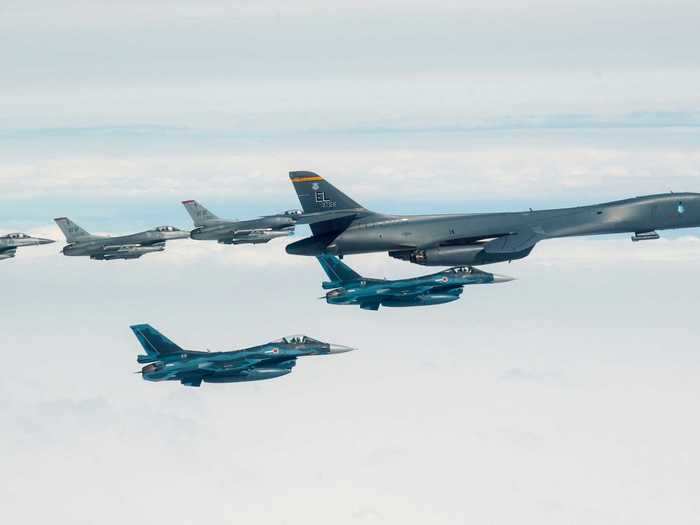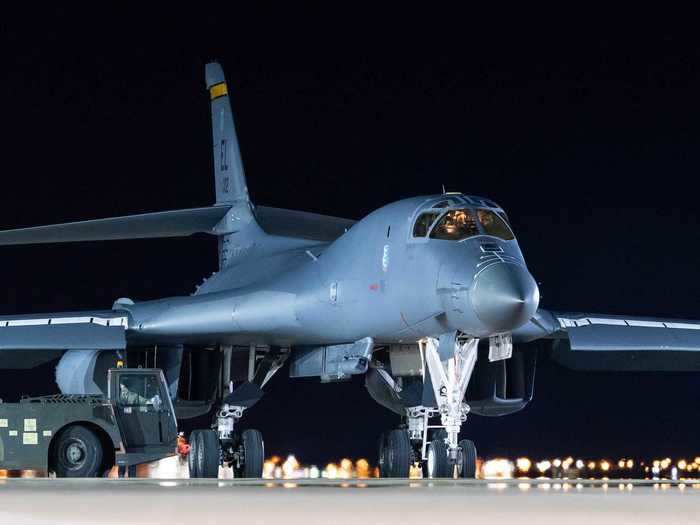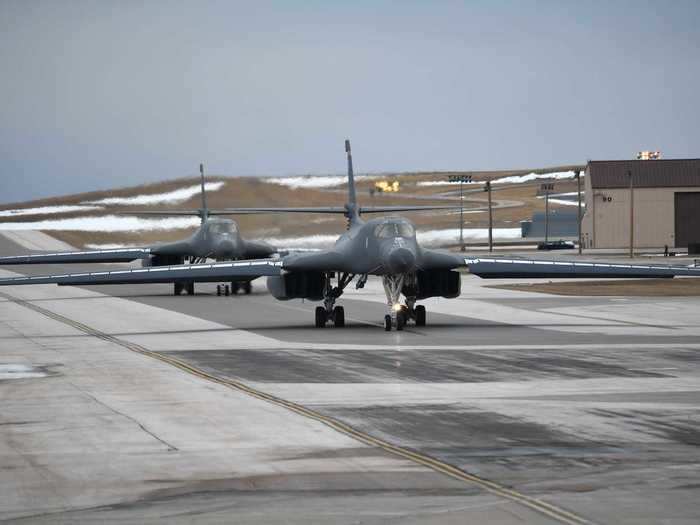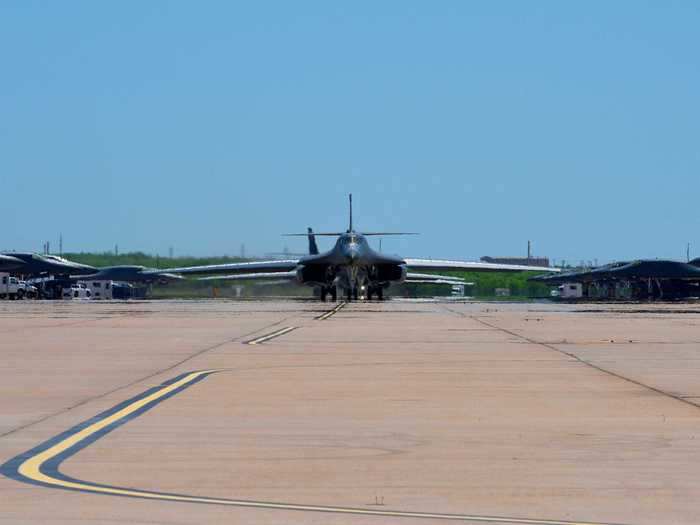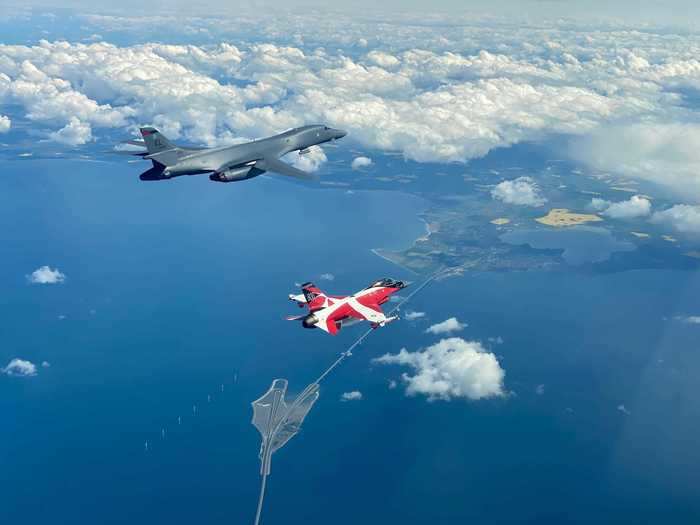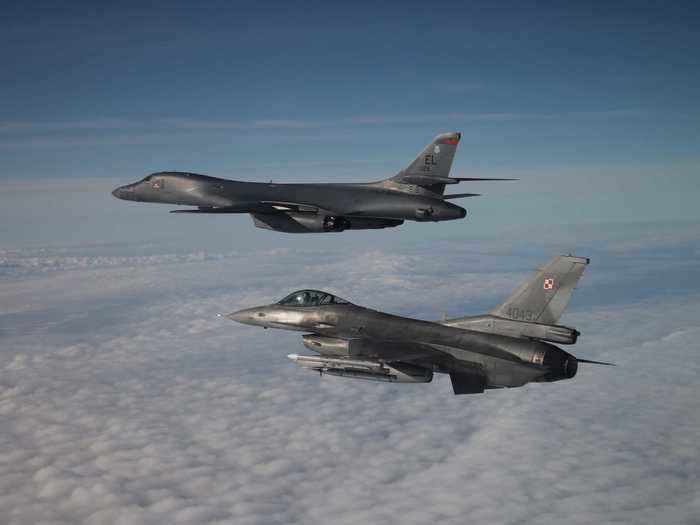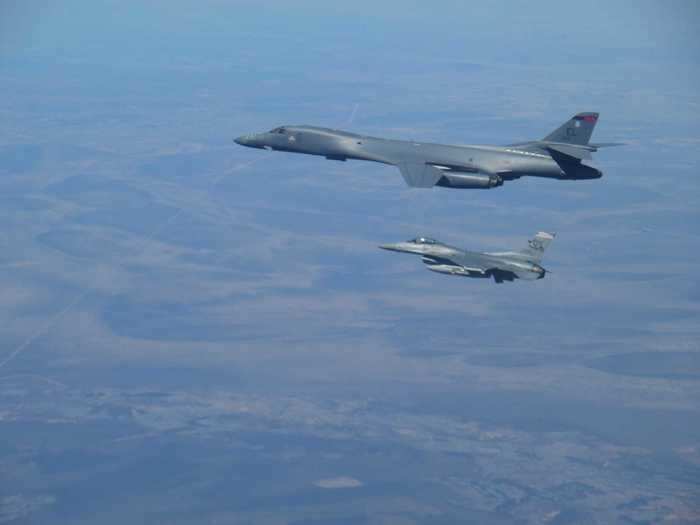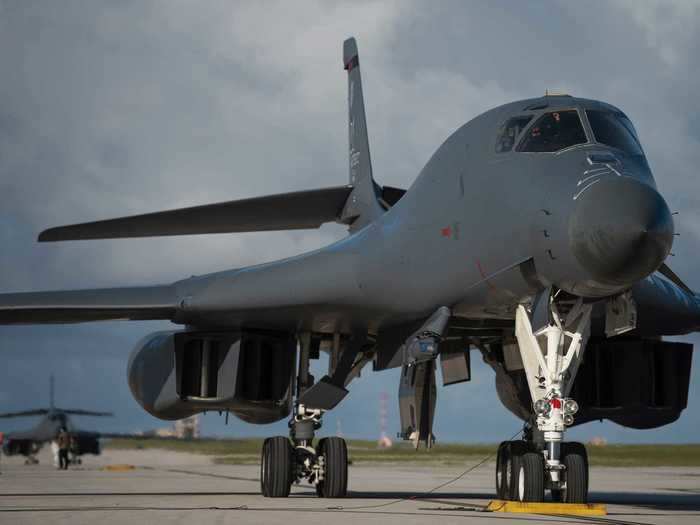A 9th Expeditionary Bomb Squadron B-1B Lancer trains Japan, where it trained with the Japan Air Self Defense Force, May 12, 2020.US Air Force/Senior Airman River Bruce
- The Air Force has said it wants to start retiring the B-1B Lancer bomber, a workhorse aircraft that has played a major role in counter-terrorism operations in recent years.
- Despite those plans, the service continues to put the bomber through its paces, including several training operations in late April and early May that took it to opposite ends of the earth on short notice.
If the Air Force gets its way, the B-1B Lancer will soon be on its way out of the fleet, but its potential departure doesn't mean any less work for the bomber.
The B-1B was one of several aircraft the Air Force proposed divesting in its 2021 budget. The B-1B fleet would drop from 61 aircraft in 2020 to 44 in 2021, and the remainder would go out of service as the new B-21 bomber arrives starting in the mid-2020s.
The B-1B is considered the "backbone" bomber fleet, as it can fly the fastest, topping 900 mph, and has the largest payload, up to 75,000 pounds of guided and unguided weapons, though it is unable to carry nuclear weapons.
But the Lancer has borne much of the workload during the war on terror, an effort needed to keep it flying led the Air Force to decide to retire some and allow maintainers to focus time and resources on the ones that are in better shape.
Despite those issues, all the Air Force's B-1Bs "are completely safe," Air Force Global Strike Command, which oversees the bomber fleets, said in an email.
The list of B-1Bs being considered for retirement "has not been finalized," and the final list will be "data driven and composed primarily of those aircraft that have the least remaining structural life," the command said.
The Air Force is maintaining B-1B combat effectiveness "until key modernization milestones are achieved"; therefore, the command said, "outside of planned scheduled maintenance, all 17 aircraft will continue flying with the rest of the fleet."
And that fleet remains busy. The Air Force promoted at least seven missions between late April and early May, photos of which you can see below, that took the Lancer and airmen supporting it all over the world.
Read the original article on
Business Insider
On April 22, a B-1B Lancer from the 37th Bomb Squadron left Ellsworth Air Force Base in South Dakota for the Indo-Pacific region, where it trained with the Japanese Air Self-Defense Force.
A US Air Force B-1B and F-16s conduct joint training with Japan Air Self-Defense Force F-2s off the coast of northern Japan, April 22, 2020.
US Air Force/Tech. Sgt. Timothy Moore
The operation was a demonstration of the Air Force's dynamic force employment model, the service said.
It entailed a nearly 29-hour round-trip flight and involved working with six US Air Force F-16s, seven JASDF F-2s, and eight JASDF F-15s as part of a joint US Indo-Pacific Command and US Strategic Command bomber task force mission.
On April 28 and April 29, B-1Bs from Ellsworth again demonstrated the Air Force's dynamic force employment model in the Indo-Pacific, flying a 32-hour round-trip sortie to conduct operations over the South China Sea.
The crew piloting a B-1B Lancer prepare to park at Ellsworth Air Force Base in South Dakota, April 30, 2020.
US Air Force/Tech. Sgt. Jette Carr
The 32-hour non-stop flight was part of a joint US Indo-Pacific Command and US Strategic Command bomber task force mission.
Such "missions are important because they allow us to demonstrate and showcase our nation's dynamic force employment capabilities," Col. David Doss, 28th Bomb Wing commander, said in a release.
The mission, Doss added, "demonstrate our commitment to our allies and partners, as well as show any potential adversary, that we can deliver overwhelming long-range global strike capabilities anytime, anywhere, regardless of whether we are at home or deployed abroad."
On May 1, B-1Bs from the 28th Bomb Wing, based at Ellsworth, flew over South Dakota cities to honor healthcare workers on the front lines of the fight against the coronavirus.
B-1B Lancers assigned to the 28th Bomb Wing at Ellsworth Air Force Base, South Dakota, leave the parking apron of the flight line, January 22, 2020.
US Air Force/Staff Sgt. Hailey Staker
The flyovers were part of the Air Force Salutes initiative and were allowed as part of an approved training mission.
"This is one way we can show our extreme appreciation and admiration for all of the men and women in our area healthcare facilities who are working tirelessly to combat this virus and provide care for our families, friends and neighbors," Doss said.
Also on May 1, B-1Bs from Dyess Air Force Base in Texas departed for the Indo-Pacific region to conduct bomber task force operations out of Andersen Air Base in Guam.
A line of B-1B Lancers from the 9th Bomb Squadron taxi before departing on a bomber task force deployment, at Dyess Air Force Base in Texas, April 30, 2020.
US Air Force/Senior Airman Mercedes Porter
Four bombers and about 200 airmen from the 9th Bomb Squadron deployed to support Pacific Air Forces' training efforts, the Air Force said in a release.
Three of the B-1Bs flew to Andersen while one flew east of Japan to train with the US Navy before heading to Anderson.
The B-1B's large payload and other features make it a valuable asset in the Indo-Pacific, where potential targets can be far-flung.
"The B-1 is able to carry a larger payload of Joint Air-to-Surface Standoff Missiles and a larger payload of 2,000-pound class Joint Direct Attack Munitions," Lt. Col. Frank Welton, Pacific Air Forces' chief of operations force management, said in a release.
"Additionally, the B-1 is able to carry the [Long Range Anti-Surface Missiles], giving it an advanced stand-off, counter-ship capability," Welton said. "It also has an advanced self-protection suite and is able to transit at supersonic speeds to enhance offensive and defensive capabilities."
On May 5, two B-1Bs from Ellsworth headed in the opposite direction, deploying for a long-range strategic bomber task force mission to the Baltic region. The flight included training with Danish F-16s and an overflight of Lithuania, Latvia, and Estonia.
A B-1B Lancer flies with a Danish F-16 during a training mission for Bomber Task Force Europe, May 5, 2020.
Danish Air Force
During the flight, which lasted more than 25 hours, B-1s also worked with Estonian joint terminal air controllers on close-air-support training with inert devices.
"Our crews gain valuable experience operating in a region that some had not seen previously," Col. Richard Barksdale, commander of the 28th Operations Group, said in a release. "This mission honed integration with NATO allies and regional partners, and demonstrated our ability to effortlessly shift operations from one area of the globe to another in a short period of time."
A B-1B from the 28th Bomb Wing at Ellsworth did a second long-range strategic bomber task force mission to Europe on May 11. With support from a KC-135 tanker, the bomber was able to make the flight, which included training with Danish F-16 and flying over Poland, Latvia, and Lithuania with Polish F-16s and MiG-29s.
A B-1B Lancer with a Polish F-16 during a long-range, long-duration training mission for Bomber Task Force Europe, May 11, 2020.
Polish Air Force
The nearly 24-hour, non-stop mission covered more than 9,400 nautical miles and was the fourth time in just over four weeks that B-1Bs from South Dakota conducted long-duration sorties, the Air Force said. Those operations took place in both the Pacific and European theaters.
This mission, like the others on this list, came amid the Pentagon's ongoing response to the coronavirus pandemic.
"The health of our team has been a top priority from the start of our COVID response and is key to sustaining missions like the Bomber Task Force," Gen. Jeffrey L. Harrigian, commander of US Air Forces Europe, said in a release. "Although mitigation efforts created challenges to overcome, our allies, partners and adversaries should make no mistake that we are ready, able and willing to deter and defend when called upon."
As one B-1B teamed up with European partners on May 11, another supported NORAD efforts to demonstrate the air-defense capabilities of Canada and the US.
NORAD CF-18s and F-16s conducted intercepts of a B-1B as it entered the Canadian Air Defense Identification Zone and the Continental US NORAD Region.
NORAD
The air-defense exercise included an intercept of at least one B-1B by Canadian CF-18s and by US F-16s, supported by KC-135 stratotankers, as the bomber entered the Canadian Air Defense Identification Zone and again as it entered NORAD's Continental US Region.
NORAD is a binational agreement that divides the region into Alaskan, Continental US, and Canadian sections, monitored by their respective authorities.
Those multiple intercepts "exercised our ability to defend the homelands," Gen. Terrence O'Shaughnessy, commander of NORAD and of US Northern Command, said a release. "While we are combatting COVID-19 we remain closely linked with our other combatant commands. Our collective work enhances our ability to deter, detect and, if necessary, defeat any threat to North America."
The late April and early May flights weren't "an increase in operational tempo," Global Strike Command said, adding that between Dyess and Ellsworth, "the B-1B flies on average between 20 to 30 sorties a week. ... The recent flights represent a small sample size of what the B-1B fleet flies from week to week."
Two 9th Expeditionary Bomb Squadron B-1B Lancers wait to park at Andersen Air Force Base in Guam a training mission in the East China Sea in support of a bomber task force, May 14, 2020.
US Air Force/Senior Airman River Bruce
The 2021 defense budget has yet to be finalized, so the future composition of the bomber force remains to be determined.
With the B-21 not scheduled to enter service until the middle of this decade, Air Force officials are discussing ways to get more out of the service's remaining bombers.
For the B-1B, this could mean changing the way pilots fly it and increasing its payload to carry the weapons of the future.
Gen. Timothy Ray, head of Air Force Global Strike Command, has said he wants to get the bomber fleet up over 220 aircraft.
There are "multiple ways" to do that, Ray said during a Defense Writers Group conference call in April.
"Right now, the short-term in any path forward includes working our way through sustaining the B-1 and adding capacity [to it] ... to sustain the B-2 until the B-21 is coming off the line at the numbers we need," Ray said.

